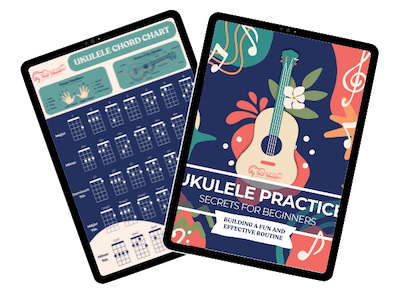Welcome to our Ukulele Chord Library!
Ukulele Chord Library
Select a ukulele chord to view from the dropdown menu below...
Note: We are constantly updating this page, so if you don’t see the chord you want, let us know via our contact us page and we will add it in.
How to Read Ukulele Chord Diagrams
Understanding chord diagrams is essential for learning new chords. Here’s a quick guide:
Strings: The vertical lines represent the ukulele strings, from left to right: G (4th string), C (3rd), E (2nd), and A (1st).
Frets: The horizontal lines indicate the frets. The top line represents the nut (the top of the fretboard), and the lines below represent the subsequent frets. Sometimes numbers are used to indicate the starting fret if not the nut.
Dots: Colored dots show where to place your fingers. Blue bars indicate you use one finger to play multiple strings (barre).
Numbers: Sometimes, numbers are placed on the dots to indicate which finger to use: 1 (index), 2 (middle), 3 (ring), 4 (pinky).
Open Strings: An “O” above a string means you play it open (don’t press any fret).
Muted Strings: An “X” above a string means you don’t play that string.

Grab a FREE Ukulele Chord Chart and Ebook Bundle!
- Quickly reference common chords,
- Learn how to structure practice sessions,
- Approach the ukulele with a positive mindset!
Browse Ukulele Chord Articles

Major vs. Minor Chords on Ukulele: What’s the Difference and Why It Matters



Mastering Ukulele Barre Chords: A Step-by-Step Guide for Players


Ukulele Chord FAQs
What is a ukulele chord?
A ukulele chord is just a group of notes played at the same time to create a certain sound. You make chords by pressing your fingers on specific frets while strumming the strings.
How many chords should I learn as a beginner?
As many as you can! But really, you only need a small handful to start playing real songs. We recommend starting with C, G, F, and Am. With those four, you can play dozens of tunes—and build confidence as you go.
Why do chord diagrams sometimes look different for the same chord?
Some chords have different shapes called “voicings”—they sound a little different, but they’re still the same chord. All chords can be played at multiple positions along the fretboard. We focus on beginner-friendly versions first, then you can explore alternate shapes as you gain confidence.
Are baritone ukulele chords the same as regular ukulele chords?
Not quite! Baritone ukuleles are tuned differently, so the same chord shape will produce a different sound. We’ll be looking to expand this library to include baritone chords as well – so watch this space!
Can I use guitar chords on a ukulele?
It’s a common question! Some of the finger shapes might feel familiar if you’ve played guitar, but because ukuleles are tuned differently, the names and sounds won’t always match up. It’s best to use ukulele-specific chord charts (like the ones we’ve got here).
What’s a barre chord, and why do they seem tricky?
Barre chords are when one finger (usually your index) presses down multiple strings at once. They can feel a bit awkward at first, but with practice, they become super useful—especially when you want to move up the neck. We’ve got tutorials to help when you’re ready for them.
How do I know if I’m playing a chord right?
Each string should ring out clearly when you strum. If something sounds off or muted, or if there’s any buzzing, check your fingers—make sure they’re not accidentally touching another string, and that you’re pressing close to the fret.
Do I need to memorize all the chords?
Nope! Just focus on learning the ones that come up most in songs you like. Over time, you’ll start to recognize and remember more. It’s not a test—it’s a journey.

